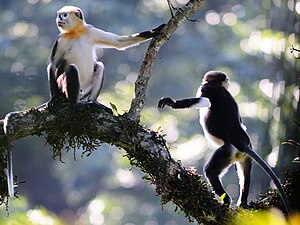Tonkin blunt nose
| Tonkin blunt nose | ||||||||||||
|---|---|---|---|---|---|---|---|---|---|---|---|---|

Tonkin blunt noses |
||||||||||||
| Systematics | ||||||||||||
|
||||||||||||
| Scientific name | ||||||||||||
| Rhinopithecus avunculus | ||||||||||||
| Dollman , 1912 |
The Tonkin snub nose ( Rhinopithecus avunculus ), also Tonkin golden monkey, is a species of primate belonging to the slender monkey group (Presbytini). Fewer than 200 of this species still live in northern Vietnam , making it one of the most threatened primate species in the world.
features
The fur of the Tonkin snub noses is black-gray on the top and whitish on the belly, on the underside of the tail and on the inside of the limbs. The head is rounded, the face is also white. Like all snub noses , this monkey is characterized by a short snub nose with openings facing forward. The skin around the eyes and nose is hairless and light blue in color, and around the mouth blackish blue. There is an orange spot on the throat. Males reach an average head body length of 65 centimeters, the tail is significantly longer with 83 centimeters. Females grow to be 54 centimeters long and have a 68 centimeter long tail. At around 14 kilograms, males are significantly heavier than females, who weigh around 8.5 kilograms.
distribution and habitat

As the only representative of the snub noses besides the Burmese snub-nosed monkeys , the Tonkin snub nose does not live in China, but in northern Vietnam , the eponymous Tonkin . Their previous area of distribution was severely restricted, today they only live in an area of around 100 km 2 in the provinces of Tuyên Quang and Bắc Kạn . Their habitat are monsoon forests .
Way of life
Tonkin snub noses are tree dwellers and, like all Old World monkeys, are diurnal. They live together in harem groups, i.e. one male, several females and their offspring. The average group size is 15 animals. The remaining males often form so-called bachelor groups. Individual groups often join together to form larger associations.
The food of these monkeys consists of leaves, fruits and seeds, but the composition of the food varies depending on the season. Leaves in spring and fruits in autumn should form the main part of the diet.
Little is known about reproduction. After a gestation period of around 200 days, the female gives birth to a single young.
threat
Tonkin snub noses are among the most threatened species of primate. The main reasons for this are the progressive destruction of their habitat, plus hunting. Military conflicts in the range of the species are also likely to have contributed to its decline. The IUCN estimates the total population to be less than 200 animals and lists the species as " critically endangered ".
An examination of the genetic makeup of the 125 to 130 individuals in a population in the forest area of Khau Ca ( Hà Giang province ) showed that their mitochondrial DNA shows no genetic variability .
swell
literature
- Thomas Geissmann : Comparative Primatology. Springer-Verlag, Berlin a. a. 2003, ISBN 3-540-43645-6 .
Individual evidence
- ^ Andie Ang et al .: No evidence for mitochondrial genetic variability in the largest population of critically endangered Tonkin snub-nosed monkeys in Vietnam. In: Primates. Volume 57, No. 4, 2016, pp. 449–453, doi: 10.1007 / s10329-016-0571-x
Web links
- Rhinopithecus avunculus in the endangered Red List species the IUCN 2006. Posted by: R. Boonratana, Le Xuan Canh & Vu Ngoc Thanh, 2003. Retrieved on 2 April of 2008.
- Information on Theprimata.com (English)
- Information on Animalinfo.org including links to images and distribution map